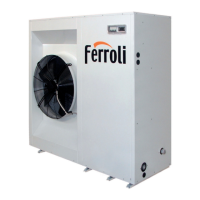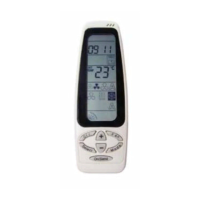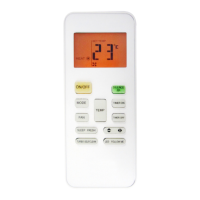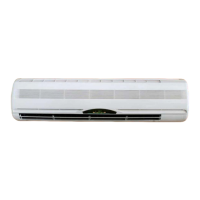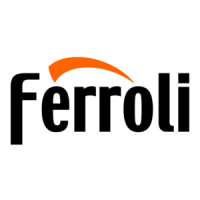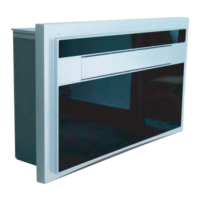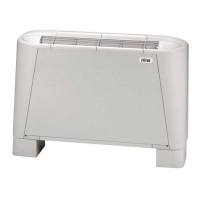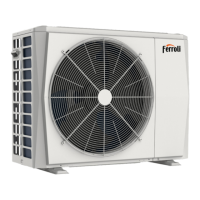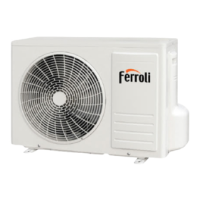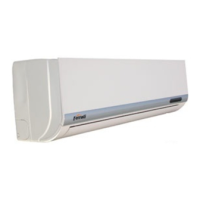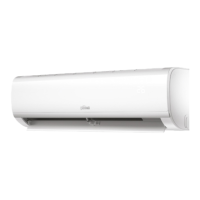Do you have a question about the Ferroli RFA and is the answer not in the manual?
Manual guidance, conformity declarations, unit dataplate details, and initial setup.
Details on unit types, configurations, and the identification code system.
Detailed description of the unit's internal and external components.
Overview of available unit configurations and optional features.
List and description of optional accessories for the unit.
General technical specifications and data for the unit models.
Standard cooling and heating capacities, power input, and EER/COP values.
Detailed cooling capacity, EER, power input, and RST graphs by inlet air temperature.
Detailed heating capacity, COP, and power input graphs by inlet air temperature.
Hot water coil performance data for different configurations and air flow rates.
Electrical heater coil performance data for different configurations and air flow rates.
Gas heating module performance data, input, and condensate generation.
Static head curves for internal fans and pressure drops for various filters.
Fan performance curves for return air, indicating static head vs. air flow.
Graph showing pressure drops related to condensate generation on the internal coil.
Graphs showing pressure drops for different filter types and air flow rates.
Pressure drop data for hot water coil heating integration.
Pressure drop data for gas heating module heating integration.
Pressure drop data for electric heater coil heating integration.
Graphs showing pressure drops for droplets separators.
Graphs showing pressure drops for air flow silencers.
Graphs showing guaranteed operating areas for cooling and heating modes.
Electrical specifications including current input, power input, and start current.
Sound power and pressure levels for unit and internal fans across settings and frequencies.
Acoustic attenuation of silencers and noise levels for return air fans.
Weight specifications for different unit configurations and accessories.
Dimensional drawings and specifications for various unit models.
Guidelines for unit placement to ensure proper airflow and prevent operational issues.
Instructions for connecting condensate drains and water coils.
Guidelines and specifications for connecting air ducts to the unit.
Diagram and specifications for downwards air flow duct connections.
Diagrams showing the position of the expulsion air damper.
Standards for electrical wiring, power supply, and user connections.
Specific connection details for the condensing gas heating module.
Instructions for checking shipment completeness and handling the unit upon receipt.
Guidelines for correct unit placement, including support and orientation.
Steps for initial unit setup, including preliminary checks and power connection.
Post-startup checks for refrigerant circuit, aeraulic circuit, and electrical circuit.
Description of the unit's microprocessor controller and user interface.
Explanation of status LEDs and accessory interfaces.
Tree structure of the control system menu and navigation.
List and characteristics of the unit's analogue and digital inputs/outputs.
Technical specifications for the controller and overview of the alarm system.
Detailed table listing alarms, causes, and recommended actions.
Troubleshooting guide for common alarm conditions and possible causes.
Explanation of user-configurable functions like set points, modes, and free cooling.
Details on NTC temperature probes, resistance values, and troubleshooting.
Configuration and use of Modbus protocol for serial communication.
Important safety precautions and basic checks for maintaining unit efficiency.
Procedures for cleaning heat exchangers and checking external fans.
Checks for electrical connections, cables, and air duct integrity.
Checking and cleaning internal and external condensate drains.
Procedures for draining and maintaining water coils during winter.
Routine checks, cleaning, and replacement procedures for air filters.
Maintenance guidance for belts, pulleys, electric motors, and fans.
Specific maintenance for pulleys, electric motors, and fan systems.
Precautions for accessing and working with the unit, residual risks, and protective measures.
Information on handling refrigerants, unit pollution, and safety cards.
Details on chemical properties, stability, reactivity, and toxicological information.
Guidelines for product transport, labeling, and relevant regulations.
Manual guidance, conformity declarations, unit dataplate details, and initial setup.
Details on unit types, configurations, and the identification code system.
Detailed description of the unit's internal and external components.
Overview of available unit configurations and optional features.
List and description of optional accessories for the unit.
General technical specifications and data for the unit models.
Standard cooling and heating capacities, power input, and EER/COP values.
Detailed cooling capacity, EER, power input, and RST graphs by inlet air temperature.
Detailed heating capacity, COP, and power input graphs by inlet air temperature.
Hot water coil performance data for different configurations and air flow rates.
Electrical heater coil performance data for different configurations and air flow rates.
Gas heating module performance data, input, and condensate generation.
Static head curves for internal fans and pressure drops for various filters.
Fan performance curves for return air, indicating static head vs. air flow.
Graph showing pressure drops related to condensate generation on the internal coil.
Graphs showing pressure drops for different filter types and air flow rates.
Pressure drop data for hot water coil heating integration.
Pressure drop data for gas heating module heating integration.
Pressure drop data for electric heater coil heating integration.
Graphs showing pressure drops for droplets separators.
Graphs showing pressure drops for air flow silencers.
Graphs showing guaranteed operating areas for cooling and heating modes.
Electrical specifications including current input, power input, and start current.
Sound power and pressure levels for unit and internal fans across settings and frequencies.
Acoustic attenuation of silencers and noise levels for return air fans.
Weight specifications for different unit configurations and accessories.
Dimensional drawings and specifications for various unit models.
Guidelines for unit placement to ensure proper airflow and prevent operational issues.
Instructions for connecting condensate drains and water coils.
Guidelines and specifications for connecting air ducts to the unit.
Diagram and specifications for downwards air flow duct connections.
Diagrams showing the position of the expulsion air damper.
Standards for electrical wiring, power supply, and user connections.
Specific connection details for the condensing gas heating module.
Instructions for checking shipment completeness and handling the unit upon receipt.
Guidelines for correct unit placement, including support and orientation.
Steps for initial unit setup, including preliminary checks and power connection.
Post-startup checks for refrigerant circuit, aeraulic circuit, and electrical circuit.
Description of the unit's microprocessor controller and user interface.
Explanation of status LEDs and accessory interfaces.
Tree structure of the control system menu and navigation.
List and characteristics of the unit's analogue and digital inputs/outputs.
Technical specifications for the controller and overview of the alarm system.
Detailed table listing alarms, causes, and recommended actions.
Troubleshooting guide for common alarm conditions and possible causes.
Explanation of user-configurable functions like set points, modes, and free cooling.
Details on NTC temperature probes, resistance values, and troubleshooting.
Configuration and use of Modbus protocol for serial communication.
Important safety precautions and basic checks for maintaining unit efficiency.
Procedures for cleaning heat exchangers and checking external fans.
Checks for electrical connections, cables, and air duct integrity.
Checking and cleaning internal and external condensate drains.
Procedures for draining and maintaining water coils during winter.
Routine checks, cleaning, and replacement procedures for air filters.
Maintenance guidance for belts, pulleys, electric motors, and fans.
Specific maintenance for pulleys, electric motors, and fan systems.
Precautions for accessing and working with the unit, residual risks, and protective measures.
Information on handling refrigerants, unit pollution, and safety cards.
Details on chemical properties, stability, reactivity, and toxicological information.
Guidelines for product transport, labeling, and relevant regulations.
| Brand | Ferroli |
|---|---|
| Model | RFA |
| Category | Air Conditioner |
| Language | English |
